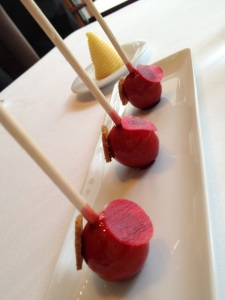At The Last Parsnip we take pride in our position at the vanguard of modern cooking. In many ways what succeeds within these four walls sets the agenda for the rest of the high-end of the ultra-premium restaurant market as a whole.
It’s therefore through this lens of personal creativity and reinvention that I present my Top 10 Food Trends for 2015.
1. Molybdenum:
Often overlooked in the kitchen, molybdenum is making quite a comeback in select higher end kitchens. Respected for both its relative inertness as well as its pleasant sheen, the metal has been used to strengthen devices as varied as poaching tongs and meat cleavers. We have employed it extensively in our own high-end food truck experience, The Fast Parsnip.
2. Triplet Servings:
Traditionally restaurants serve a dish as a single item, or occasionally as a duo. This year is seeing the rise of identical triplet servings – in dishes as varied as beet sticks, soups and even pheasants (served spread-eagled across a wide-angled serving platter). Chefs are embracing the challenge of preparing three identical servings, while customers appreciate the improved symmetry of their dishes.

A trio of beet sticks, in a linear presentation.
3. Sub-Bite Desserts:
The move towards ever-diminishing dessert sizes is picking up momentum, with an explosion in “sub-bite” offerings. These intensely challenging morsels should only be presented in parallel up to five at a time, allowing exquisite combinations of flavors to build up in the mouth. Best consumed swiftly with precision tongs.
4. Fission Cuisine:
Fusion cuisine appeared to run out of steam in 2014, replaced by the runaway success of fission cooking. Requiring a much more challenging balance of flavors, fission cuisine presents a multi–layered dining experience that is unlike any other. Dishes are typically served warm. Cold fission dishes have so far proved elusive.
5. Right-Handed Helix:
The right-handed helix (single or double) has surged back into popularity, particularly with restaurants in the Northern Hemisphere. Chefs have embraced its design simplicity, and slightly-superior taste, in dishes such as “Il Duomo“, parsnip rings and cocktail garnishes.

6. Welsh Cuisine:
Often forgotten, or just ignored, high-end Welsh cuisine has been making a strong comeback. Dishes such as Welsh Eggs, haggish and Welsh Coffee are proving most successful. Rarebit remains deeply unpopular.
7. Inverted Slicing:
The growth in inverted slicing techniques shows no signs of slowing. Rather than pushing with the knife down onto soft foods the process is inverted vertically. The knife is held firmly on the counter, and the foods are pushed down through the blade. This provides much finer control, and improves aeration in more sensitive foods such as avocado and suet.

The perfect placement for deep-slicing tripe.
8. Spheroidal Ice:
Often avoided as a space-saving nightmare, spheroidal ice has made quite a splash in the high-end cocktail scene in 2014. When prepared in-situ, using high-precision cutting equipment, it delivers a more predictable melting coefficient, and reduces splashing when lowered into the glass. Its price, at over $25 per preparation, can prove challenging.

9. Thirteen Degree Slices:
After much experimentation, we’ve narrowed down our preferred cheese slicing requirements to thirteen degrees. This is now widely recognized as maintaining the optimal balance of taste preservation, stacking efficiency, and internal strength. Several other world-renowned chefs have questioned publicly why they ever thought of slicing their cheeses differently.

Humbrian Poacher, prepared with the perfect thirteen degree slice.
10. Dark Dining:
Dark dining, already a regular favorite at the Last Parsnip, has seen amazing growth in popularity. This approach not only enhances the taste sensation for diners, but it also helps to preserve photo-sensitive foods during the entire dinner experience. Embrace this opportunity wherever it is presented.
























